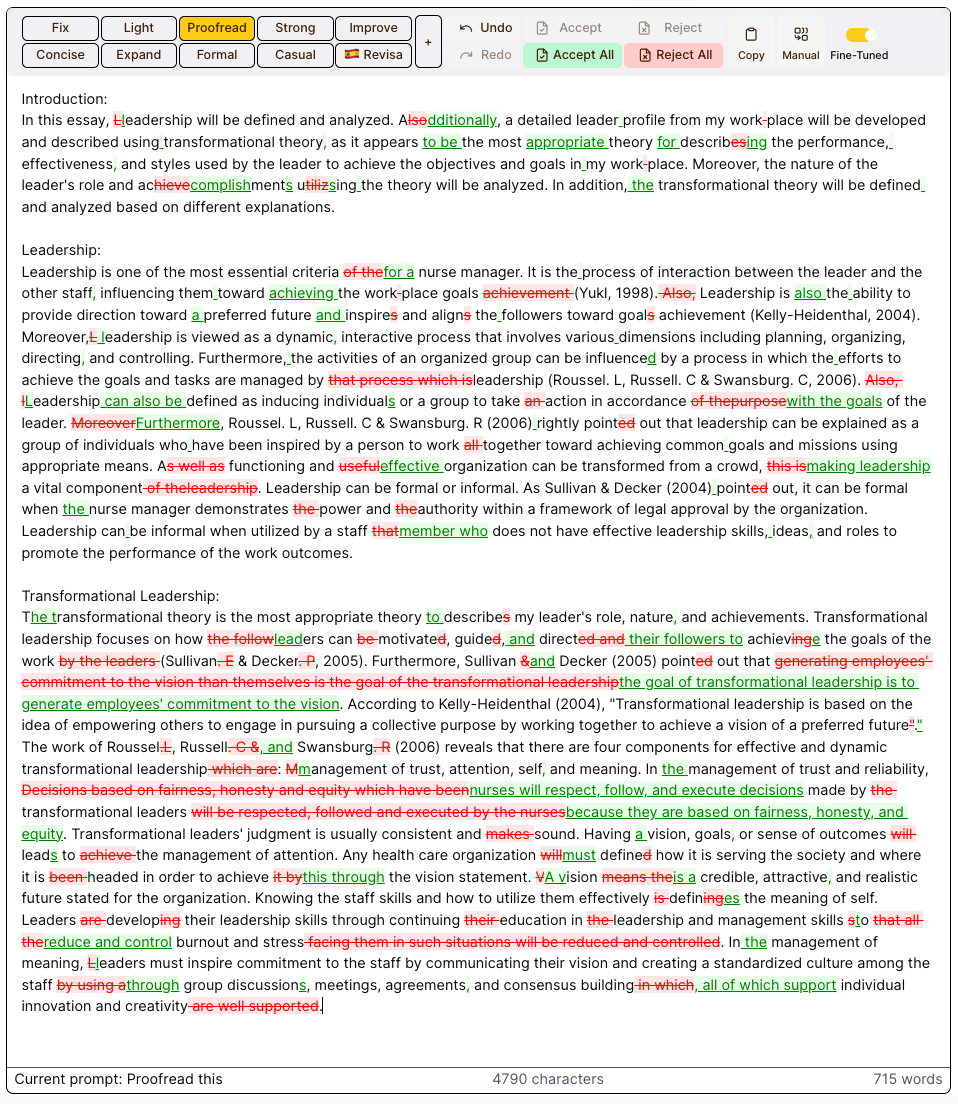Proofread Your Essay
Prompt: Proofread and improve clarity and flow
Revised with editGPT Browser Extension:
37% of passage rewritten
Original Word Count: 619
Revised Word Count: 577
Original Word Count: 619
Revised Word Count: 577
Introduction:
In this essay,Lleadership will be defined and analyzed. Also, a with a focus on transformational theory. A detailed leader profile from my work place will be developed and described, ustilizing transformational theory as it appears the most theory describesthe most comprehensive framework for explaining the performance, effectiveness, and styles used by the leader to achieve the objectives and goals inmy work place. Moreover, the nature of the leader's role and achievement utilizingthe theory will be analyzed. Furthermore, the nature of the leader's role and achievements will be analyzed through the lens of transformational theory. In addition, the transformational theory will be defined and analyzcritically evaluated based on differentvarious explanations.
and interpretations.
Leadership:
one of the most essential criteria of thea crucial aspect of being a nurse manager. It is theprocess ofnvolves the interaction between the leader and the other staff members, which influencinges themtoward the to work towards achieving work place goals achievement (Yukl, 1998). Also, Leadership is theability toEffective leadership involves provideing direction toward preferred futureand inspiresing and aligns theing followers towards goals achievement (Kelly-Heidenthal, 2004).
Moreover,Leadership is viewed as a dynamic and interactive process that involvencompasses various dimensions including, such as planning, organizing, directing, and controlling. Furthermore,tThe activities of an organized group can be influenced by a process inmanaged by the leader, which theeffortlps to achieve the goals and tasks are managed by that process which isleadership (Roussel. L, Russell. C, & Swansburg. C, 2006). Also, lLeadership can be defined as the ability to inducinge individuals or a group to take an action in accordance of thepurpose of the leader. Moreover,with the leader's purpose.
According to Roussel. L, Russell. C, & Swansburg. R (2006)rightly pointed out that, leadership can be explaindescribed as a group of individuals who have been inspired by a personleader to work all together towards achieving common goals and missions using appropriate means. As well. Effective leadership transforms a group into as functioning and usefulproductive organization can be transformed from a crowd, this is a vital component of theleadership. (Roussel, Russell, & Swansburg, 2006).
Leadership can be both formalorand informal. As Sullivan & Decker (2004)pointed out, it can be formalFormal leadership occurs when the nurse manager demonstrates the power and theauthority within athe framework of legal approval by the organization. Leadership canbe informal when utilized by a staff that does not have (Sullivan & Decker, 2004). Informal leadership is when staff members with effective leadership skills, ideas, and roles to promote the performance of thwork outcomes, even if they do not have wfork outcomes.mal leadership positions (Sullivan & Decker, 2004).
Transformational Leadership:
Transformational theory is the most appropriatetheory describesdescription of my leader's role, nature, and achievements. Transformational leadership focuses on how the followers can be motivateding, guideding, directeding, and achieving the goals of the work bythrough the leaders (Sullivan. E & Decker. P, 2005). Furthermore, Sullivan & Decker (2005) pointed out thatThe goal of transformational leadership is to generatinge employees' commitment to the vision rather than to themselves is the goal of the transformational leadership(Sullivan & Decker, 2005). According to Kelly-Heidenthal (2004), "Ttransformational leadership is based on the idea of empowering others to engage in pursuing a collective purpose by working together to achieve a vision of a preferred future". The work of Roussel.L, Russell. C & Swansburg. R (2006) reveals that there are four components for effective and dynamic transformational leadership which are.
Effective and dynamic transformational leadership consists of four components, as revealed by the work of Roussel, Russell, & Swansburg (2006):Mmanagement of trust, attention, self, and meaning. In the management of trust and reliability, Ddecisions made by transformational leaders based on fairness, honesty, and equity which have been made by the transformational leaders will bare respected, followed, and executed by the nursefollowers. Transformational leaders' judgment iss are usually consistent and makes sound. Having a vision, goals, or sense of outcomes will leads to achieve the management of attention. Any health care organization will defined how it is serving the society and where it is been headed in order to achieve it by the vision statement. Vision means the credible, attractive and realistic future stated for the organization. Ks its purpose and direction through its vision statement. Self is defined by knowing the staff's skills and how to utilize them effectively is defining the meaning of self. Leaders arecan developing their leadership skills throughby continuing their education in the leadership and management skills so that all the burnout and stress facing them in such situations will be reduced and controlled. Into reduce burnout and stress. In the management of meaning, Lleaders must inspire commitment to the staff by communicating their vision and creating a standardized culture among the staff by using athrough group discussions, meetings, agreements, and consensus building in whichwhile supporting individual innovation and creativity are well supported.
In this essay,
Leadership:
Moreover,
According to Roussel
Leadership can be both formal
Transformational Leadership:
Transformational theory is the most appropriate
Effective and dynamic transformational leadership consists of four components, as revealed by the work of Roussel, Russell, & Swansburg (2006):
The image below is a screenshot from the new editGPT editor.
